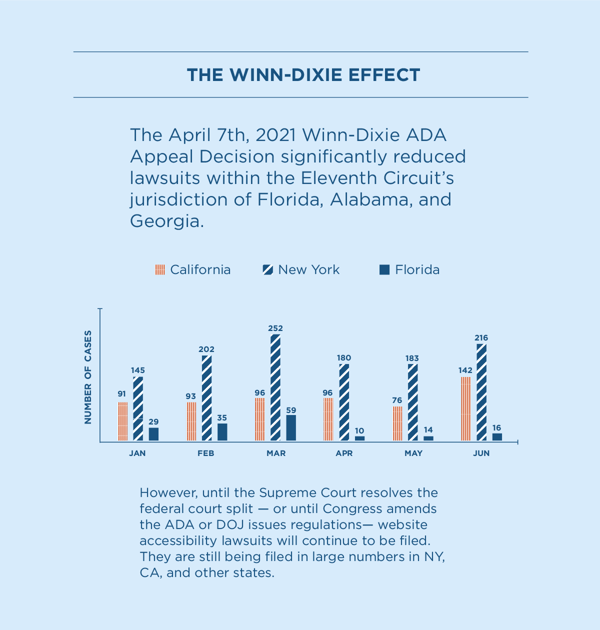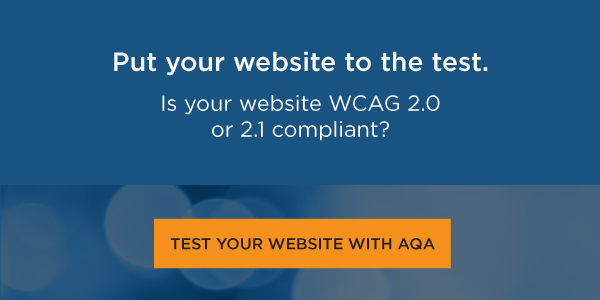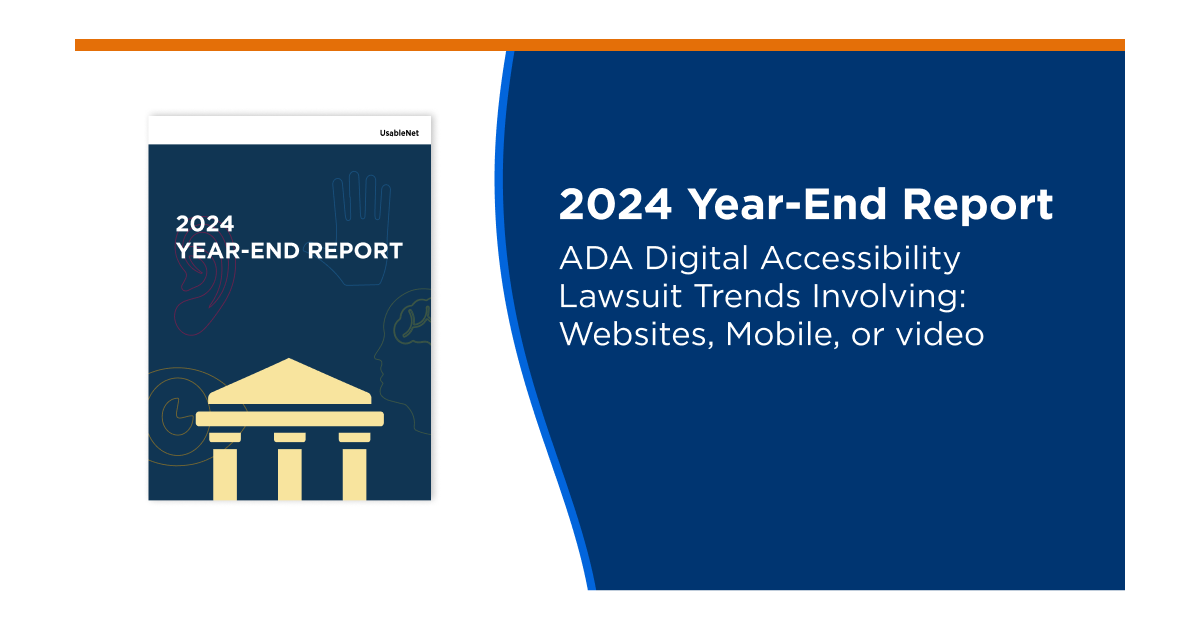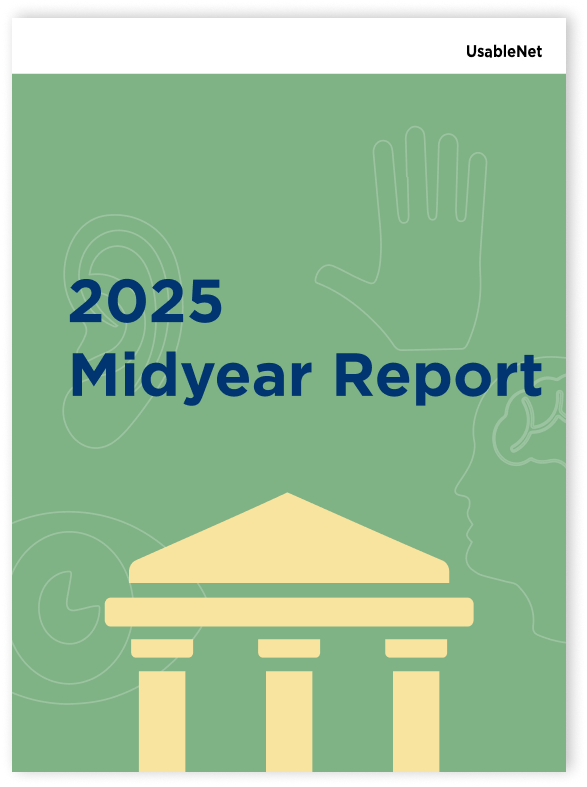ADA digital lawsuits have been increasing steadily over the past ten years, and 2021 is on track to be another record-breaking year. Based on midyear ADA lawsuit numbers, more than 4,000 digital accessibility lawsuits may be filed against companies in 2021.
At UsableNet, every couple of months, we like to provide an update with a legal speaker or speakers who are qualified and experienced in ADA digital accessibility cases. In this post, we'll take a look at our June webinar, Legal Update: The Litigation Landscape for ADA Digital Lawsuits. Our featured presenters, Peter Shapiro, Partner, New York, and New Jersey; Vice-Chair of the Labor & Employment Practice at Lewis Brisbois, and Melissa Daugherty, Partner, Los Angeles; Vice-Chair of the Labor & Employment Practice, and Chair of the ADA Compliance & Defense Practice at Lewis Brisbois discussed how we got here, current trends in ADA legal cases, and what to do if you receive an ADA demand letter.
A Quick Disclaimer before you continue reading: This blog and webinar materials are for educational purposes only. The information is not intended nor should it be considered legal advice for any specific matter and does not create an attorney-client relationship. The recipient of this publication should not rely on its contents for any specific legal purpose. If legal advice is required for any specific matter discussed herein, please consult with qualified legal counsel in your jurisdiction.
The Rising Tide of ADA litigation for Website and Mobile
The Americans with Disabilities Act (ADA) has been around for 31 years. The drafters of the ADA did not contemplate what the Internet would become; it was still in its infancy.
Between the years 2000 and 2015, we did not see many private ADA lawsuits for digital accessibility. The DOJ was involved in the settlement of lawsuits and it seemed to establish that websites and mobile apps are “places of public accommodation” and covered under the ADA.
Then, at the end of 2017, the DOJ declined to adopt formal regulations. Private ADA lawsuits for digital accessibility have filled this void.
From 2017 to 2018, the number of private ADA lawsuits for digital accessibility increased by 181%. Since 2018, we've had well over 2,000 private ADA lawsuits each year.

ADA Digital Lawsuits
Gil v. Winn-Dixie
In 2017, we had the Gil v Winn-Dixie case, which marks the first web accessibility case that was tried to verdict. There may have well-been cases that went to trial that didn't actually make it to the end. Gil v Winn-Dixie did make it to the end.
In April 2021, the Eleventh Circuit (Florida, Georgia, and Alabama) found that Winn Dixie’s limited accessibility site, at the time of the lawsuit in 2017, didn’t violate the rights of the blind plaintiff under the ADA. Winn-Dixie argued that they didn't need to be fully accessible because they are not an e-commerce site.
Many businesses today are moving to e-commerce perhaps even more rapidly because of the pandemic, because of the prevalence of people wanting to complete their purchases for groceries at home. It is far from clear that if this had been an e-commerce site if the 11th circuit would have come down the same way.
It is also important to know that there is an effort underway to get the 11th circuit to change its mind. That can still happen.
In the meantime, ADA digital accessibility lawsuit cases have cases dropped off in Florida as a result, even though previously it was one of the top three states for ADA digital lawsuits.
We're calling this "The Winn-Dixie Effect."

Will there be fewer ADA Digital lawsuits in the future?
Even with the Winn-Dixie ruling, lawsuits have not slowed significantly. Since June, California and New York have continued to have large numbers of ADA cases filed. We could easily see over 4,000 lawsuits this year.
According to our June webinar presenters, who defend against ADA lawsuits in New York and California, we’re likely only to see the number of ADA digital lawsuits reduce if one of these three things happen:
- The Supreme Court resolves the federal court split
- Congress amends the ADA
- The DOJ issues regulations
Trends in ADA Lawsuits for Digital Accessibility
Keep in mind that mobile websites, mobile apps, and desktop websites must all be accessible.
Video accessibility lawsuits are also on the rise, with over 100 cases as of June 2021.
Finally, lawsuits for companies using accessibility widgets and overlays have seen a rise in cases filed against them, a trend that began in late 2020.
Fighting ADA Lawsuits: What You Need to Know
If you receive an ADA Demand letter, it's best to consult a lawyer with experience in ADA cases and talk through your options.
We asked our two ADA attorneys from Lewis Brisbois who participated in our webinar, Legal Update on Digital Accessibility Lawsuits for June, "What type of advice do you give to a company that gets a lawsuit? What happens when a company receives an ADA lawsuit?"
The answer was simple, "Have you had your website evaluated for accessibility?"
Some companies that receive ADA lawsuits have not heard of digital accessibility at all and others are aware and believe they are accessible.
No matter which category you fall into, the best advice is to make sure you are compliant. Some demand letters will have more validity to them than others.
According to our speakers, when you’re determining what to do when you’re impacted with an ADA lawsuit, you need to consider the following:
- What is being targeted?
- What will it cost to fight, and what is the cost to settle?
- What is the cost of fighting and losing? How do the options weigh against each other?
- You need to consider the following costs:
- Costs of defense, whether you do or don’t have insurance
- Potential remediation costs
- Business disruption
- Risk of adverse outcome
- Cost of settlements
Can insurance help with ADA lawsuits?
If you have insurance, check to see if they have policies covering ADA website claims. Some will specifically exclude ADA claims altogether, and others will treat claims differently depending on whether the claim includes a damage component. Keep in mind that regardless of what insurance policy you have, remediation is often not covered.
Settling vs. Fighting: Which is Best
There is a point where the cost of defense might very well exceed the cost of settlement. All of this depends too on whether or not you have viable arguments.
Settlements are private; judgments are public and can have negative impacts on a company’s reputation. You have a chance of winning if you have strong compliance; it’s the best defense.
If you know that the plaintiff can’t provide a condition of the website that amounted to a barrier based on their disability, you have a defense. And in some jurisdictions, Plaintiffs are required to provide an actual intention to be a patron of the business.
When considering settling, you might think about the following:
- What amount will make the plaintiff and their attorney accept and go away?
- What is your tolerance for the uncertainties of litigation?
- Will settling encourage copycat lawsuits? There’s no evidence of this to date, but it could happen.
There’s always the chance that if you fight an ADA lawsuit, the court can decide that the site or app just isn’t “good enough.” There’s the uncertainty of the standards applied.
One of the main issues is the ambiguity as to what really is compliance. Most often in these cases, the plaintiff has always done some leg work. It's common for the plaintiff to have a report of issues they encountered when using your website or app.
If you've done some website accessibility work, it's important to document that. You can leverage a solution like UsableNet's ADA Monitoring Service to show that you are doing the work. Have your own testers from the disability community that can say, "actually, we are able to use the website."
Settling will not make the requirement to address accessibility issues go away, and compliance demands in settlement can be very expensive. Again, if you receive an ADA demand letter for digital accessibility an experienced defense attorney can guide you through your options.
Digital Accessibility is the Best Defense Against LAwsuits
Whether you decide to settle or fight, you always want to make sure your website and apps are accessible and compliant. Accessibility is the best defense against lawsuits, and more importantly, it ensures that your customers keep coming back.
Work with an accessibility team to ensure that your site is brought up to the WCAG 2.1 AA standard, document your efforts, run audits, and publish an accessibility statement.
Working with an experienced Accessibility Expert who can help with audits, guidance, and access to user testing is critical. If you are looking for a partner to guide you, UsableNet has 20 years of experience in digital accessibility and is a recognized industry leader.
Learn more about the Accessibility Audits and Support Services from UsableNet, or feel free to contact us.
Thank you for reading this webinar wrap-up! Register to watch the full webinar on-demand here.
Remember: This blog and webinar materials are for educational purposes only. The information is not intended nor should it be considered legal advice for any specific matter and does not create an attorney-client relationship. The recipient of this publication should not rely on its contents for any specific legal purpose. If legal advice is required for any specific matter discussed herein, please consult with qualified legal counsel in your jurisdiction.












